Penderyn is a rural village in the ancient county of Breconshire, situated near Hirwaun, and lies on the A4059 road between Hirwaun and Brecon. The village grew as a farming village which supplied food to the ever expanding coalmining town of Aberdare and lies within the boundary of the Brecon Beacons National Park. The village is more famous as being the home of the World renowned Penderyn Welsh Whisky distillery. The original war memorial for the village is situated inside St. Cynog’s Church, but as the Church sadly closed in 2016, the locals decided to erect a new war memorial, which now sits within a memorial garden in the village and commemorates the fallen of the Great War and World War Two. Two of the men commemorated on the memorial are buried in St. Cynog’s Churchyard.
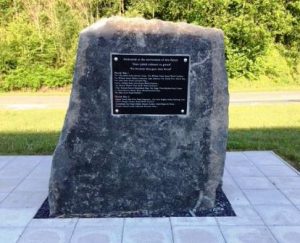
The Great War, 1914-1918
Richard Davies, Private, 8557, Dorsetshire Regiment. Richard was born at Abercanaid on 2 August 1878, the son of John Aubrey Davies and Rachel Davies (nee Thomas). His mother’s parents ran the Brecon Arms at Penderyn, and Richard lived with his grandfather there for several years as a young boy, before going to live in America with his parents for several years, as his father ran a colliery in Pennsylvania. Upon the family’s return to Wales, Richard finished his education at Penderyn, before leaving home to enlist into the Somerset Light Infantry on 24 April 1899 and served in South Africa during the Anglo-Boer War of 1899-1902. After the war he returned to Wales again and began work at the Tower Colliery. He married Catherine Thomas at Glynneath on 31 May 1906, and the couple moved to 30, Station Road, Hirwaun, where they had two children over the coming years. As an army reservist, Richard was mobilised at the outbreak of war, re-joining his old regiment, the Somerset Light Infantry. He was transferred to the Dorsetshire Regiment the following month, before embarking for France on 28 December 1914, joining the 1st Battalion, Dorsetshire Regiment. The battalion was attached to 15 Brigade, 5th Division and was resting at billets at Bailleul when Richard arrived. On 4 January 1915, the battalion moved back into the line near Wulverghem to begin a routine tour in the trenches, Richard’s first taste of life on the Western Front. Over the coming weeks, his battalion rotated in the line and during its rest periods marched to billets at Dranoutre. On 3 March 15 Brigade joined the 28th Division, which had been formed from regular army units which had returned from service throughout the Empire and moved to new positions in the Ypres Salient. Richard was wounded in the left shoulder and side by shell fragments on 8 April and was treated at the 14th Field Ambulance before being evacuated by No 7 Ambulance Train to the 4th General Hospital at Versailles. He died there of his wounds on 17 April 1915. The 36-year-old was buried in Les Gonards Cemetery, Versailles, France.
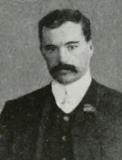
David Morton Wayne Evans, Lieutenant, Monmouthshire Regiment. David was born in 1897, the son of John William Evans and Elizabeth Ann Evans (nee Richards), of Belle Vue, Hirwaun. He enlisted into the 24th (2nd Sportsman’s) Battalion, Royal Fusiliers soon after the outbreak of war. The battalion was raised in London by Emma Cunliffe-Owen on 20 November 1914, then in June 1915 moved to Clipstone Camp, Notts, to join 99 Brigade, 33rd Division. David embarked for France with his battalion on 15 November 1915, and the entire 33rd Division assembled near Annequin in the Loos Sector. The 24th Royal Fusiliers then transferred to the 2nd Division, which was at Fontes. In the summer of 1916, the Division were on the Somme, taking part in the Battle of Delville Wood; the Battle of the Ancre, and the ensuing Operations on the Ancre. In March 1917, the Division followed the German Retreat to the Hindenburg Line, and in April took part in the Battle of Arras. David left the battalion after being granted a commission as Second Lieutenant into the Monmouthshire Regiment on 25 April 1917. He served for the duration of the war but had either been wounded or contracted an illness towards the time of the Armistice, as he died at the 1st General Hospital, Cambridge on 10 April 1919. The remains of the 22-year-old were conveyed back home, and he was buried in St. Cynog’s Churchyard, Penderyn.
John Evans, Private, 13333, Welsh Regiment. John was born at Penderyn in 1872, the son of Mary Evans. Later that year his mother married Alexander Lewis, a steelworker, and the couple moved to 15, Field Street, Cefn-Coed. John enlisted into the Welsh Regiment at Merthyr soon after the outbreak of war. John embarked for France on 29 November 1914, to join the 2nd Battalion, Welsh Regiment, which was north-east of Bethune, near Richebourg, attached to 3 Brigade, 1st Division, and was rebuilding following heavy losses at Ypres. The 1st Division took part in its first major action of 1915 here on 9 May 1915, during the Battle of Aubers Ridge, when it attacked alongside the Meerut Division. The attack of the 2nd Welsh was held up by a flooded ditch, which the men forded, before being hit by heavy machine-gun fire, and a large number of casualties were suffered before the survivors withdrew. Possibly just before this, John was transferred to the 1st Battalion, Welsh Regiment, which was attached to 84 Brigade, 28th Division. The Division had been holding a section of front line running from Wytschaete to the Ypres to Zandvoorde road at the beginning of April, then on 17 April the 1st Welsh marched up to relieve the 5th Fusiliers at Broodeseinde, just beyond Zonnebeke, on the extreme point of the Ypres Salient. On 22 April the Germans launched a poison gas attack at Gravenstafel, the first such attack of the war, and broke the line which was being held by a French Colonial Division. The Canadians rushed in to plug the gap, but this heralded the opening phase of the Second Battle of Ypres and soon afterwards the 1st Welsh became dragged into the terrible fighting, suffering severe casualties. John was probably transferred just after this period. He was killed in action during another day of terrible fighting, near Bellewaarde Farm on 25 May 1915. The 43-year-old has no known grave and is commemorated on the Ypres (Menin Gate) Memorial, Belgium. John is not commemorated on the Penderyn war memorial. He also lost two half-brothers killed during the war: Evan Lewis in 1914; and David Lewis in 1914.
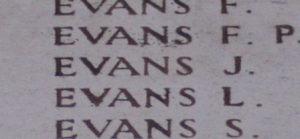
William Evans, Private, 11227, Royal Welsh Fusiliers. William was born in Penderyn in 1889, the son of Richard Evans and Mary Ann Evans (nee Williams). He worked as a coalminer prior to enlisting at Merthyr into the Royal Welsh Fusiliers on 5 August 1913 and was posted to the barracks at Wrexham to join the 3rd Battalion, Royal Welsh Fusiliers. After four months training, William was posted to the 1st Battalion, Royal Welsh Fusiliers, then embarked for Malta with the battalion on garrison duties. Following the outbreak of war, the battalion was recalled to England, sailing on 3 September 1914, and joined 22 Brigade, 7th Division at Lyndhurst, before the entire Division embarked for the front, landing at Zeebrugge on 7 October 1914. The 7th Division had gone to Zeebrugge to defend the port, but it was already in the process of falling to the Germans, so the Division moved out of the city, marching via Bruges to Ostend, where the Division then entrained for Ghent. The Division then marched to Meirelbeke, and dug in defensive positions, in support of the French and Belgians. It soon became apparent that the Germans had broken through the Belgian lines, so on 11 October the 7th Division received orders to withdraw, reaching Hansbeke by the following day, and over the coming days continued to withdraw, marching through Thielt to Roulers, and by 14 October reached Ypres, becoming the first British Division to hold the city. The remainder of the BEF moved to Ypres from the Marne soon afterwards, in time to take part in the desperate defence of Ypres, when the Germans began attacking the city on 19 October. Following the closure of the First Battle of Ypres, the 7th Division moved to positions near Neuve-Chapelle, and on 10 March 1915 took part in the disastrous Battle of Neuve Chapelle, which lasted three days for little or no gain. The 1st RWF then moved to billets at Fort D’Esquin, where it enjoyed several weeks rest behind the lines. By 7 April the 1st RWF had moved to reserve billets at Rue du Bacquerot, and four days later relieved the Royal Scots in the trenches to begin a routine tour in the line, being relieved on 14 April. The battalion enjoyed another period out of the line until 6 May, when it moved forwards again, to take part in the Battle of Aubers Ridge, where the Division launched an assault against the village of Aubers on 9 May 1915. The 1st RWF remained in the assembly trenches, in support of the assault, but the attacking troops made no gains, so the battalion was not called upon, and marched to billets in Essars. On 15 May 1915 the 7th Division took part in another assault, against the village of Festubert. The 1st RWF moved from its billets at Essars that day, marching via Bethune to its starting positions at Rue Cailloux, and at dawn on 16 May 1915 launched its assault on the German line’s opposite, ordered to seize the line running from the Rue Quinque to Rue D’Ouvert. The battalion swept through the German front and 2nd lines, before becoming held up, suffering very heavy casualties. William was killed in action during the assault that day, 16 May 1915. The 26-year-old has no known grave and is commemorated on the Le Touret Memorial, Richebourg-L’avoue, France.
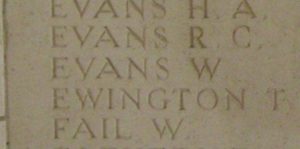
Gwilym Rhys Jones, Lieutenant, Royal Welsh Fusiliers. Gwilym was born in 1890, the son of William Jones and Catherine Jones (nee John), of Cefndon, Penderyn. He was educated in London, before beginning his career as a teacher at Hirwaun then moved to Park School Aberdare. He had been appointed headmaster of the Hook School, in Pembrokeshire, in March 1914. Gwilym originally enlisted into the 16th Battalion, Welsh Regiment, but was commissioned from the Welsh Regiment into the 6th Battalion, Royal Welsh Fusiliers on 19 March 1915. The battalion was attached to 158 Brigade, 53rd (Welsh) Division, and on 19 July 1915 sailed from Devonport for Imbros, before landing at C Beach, Suvla Bay, Gallipoli on 9 August 1915. 158 Brigade left the beach on the morning of 10 August 1915 and headed over the Salt Lake towards the Turkish positions at Scimitar Hill. The attack was muddled, and many men were caught in the open by shellfire and bullets. The survivors made their way to cover but had to remain wary of sniper fire if they moved. Gwilym was shot and killed while attempting to move forward with his men from a sheltered position and was later buried where he fell. The 25-year-old has no known grave, and is commemorated on the Helles Memorial, Gallipoli.

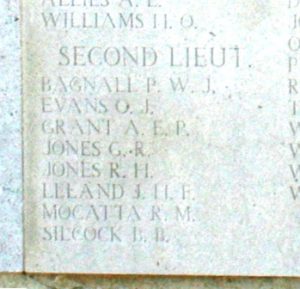
Ithel Jones, Private, STK/2161, Royal Fusiliers. Ithel was born in 1893, the son of Emrys Jones, headmaster of Hirwaun School, and Margaret Ann Jones (nee Davies), of 6, Harness Street, Hirwaun. His mother died in 1906, so young Ithel was sent away to be educated at Taunton School. Ithel then worked for Lloyd’s Bank as a as a bank clerk at Bargoed prior to the war. He enlisted at Bargoed into the army and was posted to the 12th Battalion, Royal Fusiliers, which was at South Downs attached to 73 Brigade, 24th Division. Ithel did not embark for France with the battalion when it left Britain in September 1915 but remained at home for several months before being drafted to France in the spring of 1916, joining the 10th (Stockbroker’s) Battalion, Royal Fusiliers. The battalion was attached to 111 Brigade, 37th Division and was on the Somme when Ithel arrived. The division took part in the diversionary attack on the Gommecourt Salient, during the first phase of the Battle of the Somme on 1 July 1916. Two of the Division’s infantry Brigades, the 111th and 112th, and the Divisional pioneers were then attached to the 34th Division, which had suffered very heavy losses in their attack on La Boiselle. Upon the Brigade’s returning to the 37th Division, it took part in the Battle of the Ancre. The division then moved in March 1917 and took part in the First Battle of the Scarpe, where it captured Monchy le Preux. The division then took part in the Second Battle of the Scarpe, and the Battle of Arleux before moving north to Ypres. Ithel came home for two weeks leave in July 1917, before returning to his battalion at Ypres. Here, the division fought throughout the Third Battle of Ypres, taking part in the Battle of the Menin Road, the Battle of Polygon Wood, the Battle of Broodeseinde, the Battle of Poelcapelle, the First Battle of Passchendaele and the Second Battle of Passchendaele. During March 1918 the Division was at the Somme, and fought during the German Offensive, following the German offensive which was launched on 21 March 1918. Ithel suffered terrible wounds from gas during the heavy fighting that ensued and after treatment in France was evacuated back to Britain. He died of the effects of his gas wounds at the Beaufort War Hospital, Bristol on 24 May 1918. The remains of the 24-year-old were brought home and he was buried in St. Cynog’s Churchyard, Penderyn.
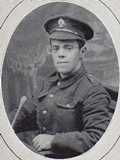
John Jones, Private, 235029, South Lancashire Regiment. John was born at Rhayader in 1896, the son of Hugh Jones and Jane Jones. By 1911 the family had moved to Caerllwyn, Rhigos, and John and his father worked as colliers. John enlisted at Aberdare into the 20th Battalion, Welsh Regiment, but after completing his training was transferred to the South Lancashire Regiment. He was drafted to France in the autumn of 1916 and was posted to the 8th Battalion, South Lancashire Regiment, which was on the Somme, attached to 75 Brigade, 25th Division. The division fought throughout the Battle of the Somme, and then moved to Ploegsteert, where it held the line for the months leading up the Battle of Messines Ridge on 7 June 1917. After fighting at Messines, the took part in the opening phase of the Third Battle of Ypres, before moving south again, taking up positions around Bullecourt in reserve. John was transferred to the 1/4th Battalion, South Lancashire Regiment around this time. The battalion was the Pioneer Battalion to the 55th (West Lancs) Division and had been decimated at the Battle of Cambrai. Following a lengthy period out of the line refitting and training, the Division relieved the 42nd (East Lancashire) Division in the front line at Givenchy and Festubert on 15 February and faced a number of enemy raids in March. April was at first much quieter, but it was a lull before the storm, as the Germans launched the second phase of their Spring offensive here on 9 April 1918. John was mortally wounded during the early hours and died of his wounds later that day, 9 April 1918. The 22-year-old is buried in Lillers Communal Cemetery, France.
John Jones, Private, T4/141562, Royal Army Service Corps. John was born at Llanbadarn, Cardiganshire in 1862, the son of John Jones and Esther Jones (nee Mason). The family had moved to Mountain Ash by 1881. John left home as a young man and moved to Penderyn, where he married Gwen Williams on 29 December 1896. The couple initially lived in Penderyn, but later moved to 43, Trevithick Street, Merthyr Tydfil, where John worked as a coalminer. John enlisted into the Army Service Corps at Pontypool soon after the outbreak of war and was posted to the 41st Division Mechanical Transport Company, Army Service Corps. The Division moved to France by 6 May 1916 and began familiarisation with trench warfare in the areas of Ploegsteert and the Douve valley, south of Ypres. It remained here until August 1916, when it moved to the Somme, and took part in the Battle of Flers-Courcelette. The Division remained in the line, pushing on to Courcelette over the next few days before coming out for a rest and re-fit. It then fought at the Battle of Le Transloy, before moving to positions south of Ypres in 1917. Here it took part in the Battle of Messines, before seeing further action during the Third Battle of Ypres, taking part in the Battle of Pilckem, and the Battle of the Menin Road. The Division was selected as one of five British Divisions to be moved to Italy, as part of a reinforcement action taken by the Allies following a disastrous defeat of the Italian Army at Caporetto. The division arrived at Mantua on 17 November 1917, where it held a part of the line on the River Piave, however, the crisis had passed and the Division was hurried back to the Western Front in early March 1918, in time to be hit hard following the launching of the German Spring offensive on 21 March 1918, and the division saw terrible fighting as it withdrew over the coming days. The battered division was then relieved and moved back to Flanders, taking over positions in the Ypres Salient. John was killed in action here within weeks of the move, on 29 April 1918. The 56-year-old is buried in Mendinghem Military Cemetery, Belgium.
Edward McKinney, Private, 13270, Princess Victoria’s (Royal Irish Fusiliers). Edward was born in Ireland in 1881. He married Mary Cordron in Ireland in 1905, then the couple left Ireland for South Wales, to find work. Edward and Mary settled at Mountain Ash, where three children were born. He enlisted there into the army soon after the outbreak of war and was posted to the 5th Battalion, Princess Victoria’s (Royal Irish Fusiliers). The battalion had formed at Armagh as part of 31 Brigade, 10th (Irish) Division and in April 1915 moved to Basingstoke. In July 1915 the division sailed from Liverpool for Gallipoli, landing at Suvla Bay on 7 August 1915. The division took part in heavy fighting at Gallipoli until being transferred to Salonika in October 1915. After almost two years there fighting the Bulgarians, the division moved to Egypt in September 1917 and took part in the Palestinian offensive over the coming months. On 30 April 1918 the 5th Royal Irish Fusiliers left the 10th Division and embarked at Port Said on 18 May for France, before arriving at Marseilles on 27 May, entraining for Northern France to join the 66th Division. Edward was transferred to the Labour Corps at some time after this, his number changing to 389137. He survived the war and was demobilised on 2 March 1919, before returning to Wales, moving his family to 3, Trebanog Cottages, Penderyn. Edward appears to have died at Penderyn in 1921. He is not commemorated by the CWGC, nor is he commemorated on the Penderyn war memorial.
David Price, Private, 76650, Welsh Regiment. David was born in 1898, the son of William Price and Elizabeth Price (nee Williams), of Tirgwynbach Cottage, Hirwaun. He worked as a collier prior to enlisting into the 114th Battalion, Training Reserve at Cardiff on 26 April 1918 and was posted to Clipstone Camp for training. David was subsequently posted to the 3rd Battalion, Welsh Regiment at Redcar, before being drafted to France on 14 September 1918. He then spent a brief time at the Infantry base Depot at Rouen before being posted to the 15th Battalion, Welsh Regiment on 18 September. The battalion, known as the Carmarthen Pals battalion, had recruited heavily in west Wales before joining 114 Brigade, 38th (Welsh) Division. Upon his arrival with the battalion, David was posted to D Company. The battalion was at Heather Trench, near Gouzeaucourt, when David arrived, having spent the previous month rapidly advancing along the old Somme battlefields of 1916. The battalion moved into reserve at Equancourt soon after, before moving on 28 September to positions at Fins Ridge Wood in brigade reserve, near the Village of Lechelles. The Hindenburg Line had now been reached and was about to be assaulted by the British Fourth Army south of Bony, then the Americans would continue the advance. The 38th (Welsh) Division was in reserve, as the Hindenburg Line was smashed at Bony and Bellicourt, then on 4 October, the division was ordered forward, crossing the canal at Bony and taking up positions in the ruined village of Aubencheul, west of Villers-Outréaux. The divisions task was to clear the heavily defended Mortho Wood. The plan was for both 113 and 115 Brigades to make the initial assault on the night of 7 October 1918, clear Mortho Wood, and hold the ground taken. In the morning of 8 October, 114 Brigade was to advance. The 13th Welsh were on the right, with the 15th Welsh on the left, with orders to pass each side of Malincourt. The 14th Welsh, with four tanks, were detailed to mop up the German defenders of Mortho Wood, and the attack was to push on, with the 15th Welsh tasked with gaining and holding the high ground at Gard Wood. David was badly wounded during this assault on 8 October, suffering gunshot wounds to his left leg, and was evacuated to the 3rd Canadian Casualty Clearing Station. After having his wounds dressed, David was sent by ambulance train to No 3 Stationary Hospital at Rouen, where his leg was amputated. David died there of his wounds on 13 October 1918. The 20-year-old was buried in St. Sever Cemetery Extension, Rouen, France.
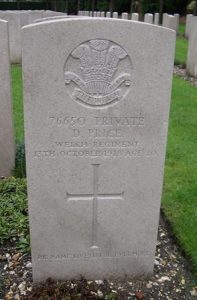
Edward Watkin Price, Lance Corporal, 21813, South Wales Borderers. Edward was born on 24 June 1893, the son of George Price and Hannah Price (nee Thomas), of 23, Pontpren, Penderyn. He worked as a collier prior to enlisting into the 11th Battalion, South Wales Borderers at Brecon soon after the outbreak of war. The battalion was at Colwyn Bay attached to the 43rd (Welsh) Division. The Division trained in North Wales before moving to Winchester in the summer of 1915, where the formation became renumbered 115 Brigade, 38th (Welsh) Division. The Division began moving to France on 2 December 1915 and moved to the Nursery Sector near Fleurbaix for trench initiation alongside the Guards Division. The Division then held a sector of the line near Cuinchy before marching south to the Somme sector in June 1916 to take part in the assault on Mametz Wood. The first attack on the wood was launched on a two-battalion front on 7 July, but failed, with the 16th Welsh and 11th SWB suffering terrible casualties due to inadequate artillery support. Edward was killed in action during that initial assault upon Mametz Wood that day. The 23-year-old is buried in Caterpillar Valley Cemetery, Longueval, France.
Roger Price, Private, 130542, Machine Gun Corps. Roger was born in 1896, the son of Roger Price and Mary Anne Price (nee Williams), of 7, John’s Row, Hirwaun. He worked as a hawker prior to the war. Roger enlisted into the South Wales Borderers at Cefn Coed in the summer of 1916 and trained as a specialist machine-gunner. Roger was then posted to the 61st Battalion, Machine Gun Corps. The battalion started life as the 267th Machine Gun Company, before embarking for France at Southampton on 13 January 1918, moving to positions at Foreste. At the end of February, the company became the 61st Battalion, Machine Gun Corps, joining the 61st (South Midland) Division at Vaux, in the Somme valley, where it was holding the forward zone of defences in the sector northwest of Saint Quentin, in the area of Ham. At dawn on 21 March 1918 the Germans launched a large-scale offensive along the section of Western Front running south from Croisilles to La Fère, and the 61st Division was hit hard by three enemy Divisions. The division put up a stubborn defence but was forced to withdraw on the afternoon of 22 March, in consequence of the enemy’s progress at other parts of the line. After suffering heavy casualties, the depleted Division was moved to Flanders to rest, but the Germans launched the second phase of their offensive here just weeks later, on 9 April 1918, and the Division became caught up in the thick of the action again, during the withdrawal to Éstaires, helping defend the vital town of Bethune. The Germans switched their attention to the Champagne region in May, so the division took over the St. Venant Sector over the coming months. On 21 August 1918 the Allies launched a general offensive along the Somme front. The 61st Division had by now gone out of the line to train, but at the beginning of September moved back into positions near La Gorgue, ready for the Allies to launch another offensive in Flanders. Roger was killed early in the advance, during heavy fighting for Rue Bataille on 7 September 1918. The 22-year-old is buried in Ration Farm Military Cemetery, La Chapelle-D’Armentieres, France.
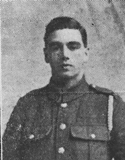
John Henry Roberts, Private, 52483, Royal Army Medical Corps. John was the son of Thomas and Martha Roberts of 1, Frolic Street, Newtown. He married Mary Emma Roberts, a farm servant from Montford Bridge, in 1906 and by 1911 the couple were living at Penderyn, where John was working as a railway platelayer. He enlisted at Brecon into the Royal Army Medical Corps soon after the outbreak of war and on 21 June 1915 was posted aboard the Hospital Ship SS Galeka. The ship had been requisitioned from the Union-Castle Line by the Admiralty and was initially used as a troop transport before being converted into a Hospital Ship with accommodation for 366 wounded passengers. On 28 October 1916 Galeka was entering Le Havre to collect wounded men from the Somme offensive when she struck a mine which had been laid by the German submarine UC-26 and sank with the loss of 19 RAMC personnel. John was 35 years old when he drowned in the sinking of Galeka. He is commemorated on the Galeka Memorial in Ste. Marie Cemetery, Le Havre, France. John is not commemorated on the Penderyn war memorial but is commemorated at Newtown.
William James Walters, Private, 14048, Somerset Light Infantry. William was born at Penderyn in 1888, the son of Thomas Walters and Phoebe Walters (nee Williams). The family moved to Ynyshir by 1891, then by 1901 had moved again to 2, Glen Terrace, Wattstown. William married Nellie Beatrice Lambourne in 1908 and the couple set up home at 1, Tyn y Berllan, Trebanog, where William worked as a coalminer. The couple had moved again to 45, Enid Street, Trealaw prior to the war. William enlisted at Tonypandy into the 6th Battalion, Somerset Light Infantry soon after war erupted. The battalion moved to Aldershot after its formation, to join 43 Brigade, 14th (Light) Division. After completing its assembly and training, the division embarked for France on 21 May 1915, disembarking at Boulogne. The Division moved into the Ypres Salient and was to see its first action during the Action of Hooge, where it infamously became the Division to be attacked by the German use of flamethrowers on 30 July 1915. Despite a gallant resistance under terrible circumstances, the Germans managed to capture and consolidate a number of craters as the division suffered severe losses. Later that year, on 25 September 1915, the 14th Division took part in a disastrous diversionary attack on Bellewaarde Farm, in an action known as the Second attack on Bellewaarde, in order to divert German attention away from the main offensive at Loos. Again, terrible casualties were suffered by the division. Over the New Year, the 14th Division moved to new positions north of Ypres, along the Canal Bank line and over the first weeks of 1916 the men of the division worked hard on improving the trenches and defensive systems. William was wounded at the end of January and was evacuated to hospital at Étaples, where he died of his wounds on 6 February 1916. The 30-year-old is buried in Étaples Military Cemetery, France.
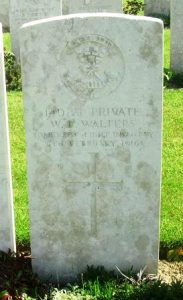
World War Two, 1939-1945
Peter McCall Bond, Wing Commander, 40073, Royal Air Force. Peter was born at Wavendon, Buckinghamshire on 23 December 1918, the son of Francis Edward Bond and Florence Bond (nee Lloyd). He was granted a commission into the Royal Air Force in 1937 and trained as a fighter pilot. Peter married Beryl Kavanagh at sometime during the war. In the summer of 1944 he joined 91 Squadron, Royal Air Force, which was equipped with the Supermarine Spitfire and was soon given command of the squadron. Over the coming months Peter brought down some seven enemy V-1 rockets. Peter survived the war but on 30 September 1946 was flying a de Havilland Hornet F1, of 32, Maintenance Unit, on a flight over mid-Wales when he crashed into a hill at Penderyn, in low cloud, and was killed. The remains of the 27-year-old were recovered from the wreckage and transported home for burial in Norwich Cemetery, Norfolk. Peter is not commemorated on the Penderyn war memorial but is added here for local interest.
Charles Horace Gordon Chick, Aircraftman 2nd Class, 1831978, Royal Air Force Volunteer Reserve. Charles was born at Bodmin in 1924, the son of Horace Percy Chick and Honorah Blanche Chick (nee Baker). The family had moved to Penderyn prior to 1933. Charles enlisted into the Royal Air Force Volunteer Reserve in 1942 and was posted to No 3 School of Technical Training, at Blackpool, in Lancashire. The school trained ground crew in the skills required to repair and maintain the Royal Air Force’s highly technical aircraft. Charles was taken ill on 14 June 1943 and was admitted to the RAF Hospital at Kirkham. He died there of meningitis five days later, on 19 June 1943. The remains of the 19-year-old were conveyed back to South Wales, and he was cremated at Pontypridd Crematorium.
Edward Jenkin Edmunds, Greaser, Merchant Navy. Edward was born at Cardiff on 5 June 1905, the son of Edward William Edmunds and Mary Jane Edmunds (nee Thomas). The family moved to Penderyn after the end of the First World War. Edward had a colourful youth, with a long list of misdemeanours to his name in the years leading up to 1931. He then enlisted into the Merchant Navy and by the time war erupted was serving as a greaser aboard the London registered cargo steamer, SS Bibury. On 23 August 1940, Bibury left Cardiff with a cargo of almost 7,500 tons of coal, bound for Buenos Aires. The steamer joined Convoy OB-205 at Milford Haven for the hazardous voyage across the Atlantic. During the early hours of 31 August 1940, Bibury was steaming together with two other freighters, dispersed from the convoy, when she was struck by two torpedoes which had been fired from the lurking German submarine U-59 and sank within five minutes with the loss of all her crew of 39. Edward was 35 years old when he died as a result of the attack. He has no known grave but the sea, so he is commemorated on the Tower Hill Memorial, London.
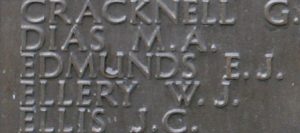
John Hughes, Corporal, 6847707, Army Catering Corps. John was born at Penderyn on 12 May 1918, the son of David Evan Hughes and Catherine Ellen Hughes (nee Chick). By 1939 the family had moved to 193, Elsley Road, Battersea, where David worked as a crane driver in the power station, and young John had begun work as a canteen attendant in the same works as his father. John enlisted into the army soon after the outbreak of war and was posted to the Army Catering Corps. After completing his training as an army cook, he was attached to the 1st Battalion, King’s Royal Rifle Corps. The battalion had been deployed to North Africa upon the outbreak of war and saw action with the 7th Armoured Division at the Battle of Sidi Rezegh in November 1941, the First Battle of El Alamein in July 1942 and the Second Battle of El Alamein in October 1942. The battalion, now part of the 2nd Armoured Brigade, was then engaged in action throughout the final stages of the Tunisian Campaign. Following the surrender of the Afrika Korps in the summer of 1943, the battalion embarked for Italy to take part in the arduous Italian campaign. John was killed in action in Italy on 13 September 1944. The 25-year-old was originally buried on the battlefield. In July 1945 John’s grave, together with several others buried nearby, was exhumed and re-interred in Coriano Ridge War Cemetery, Italy.
Morgan Jenkins, Second Lieutenant, 157336, Welch Regiment. Morgan was born in 1915, the son of Morgan Jenkins and Mary Jenkins, of 46, Halifax Terrace, Treherbert. His parents were both from Penderyn but had moved to Treherbert after his father had gained work there as a plate layer at the Ynisfaoi Mine. He was educated at Treherbert before being accepted into Brecon Boy’s County Grammar School, and upon leaving school, Morgan became a textile buyer for a drapery company in London. Morgan enlisted into the Territorial Army in 1937 and served with the King’s Royal Rifle Corps. He attested into the regular army soon after the outbreak of war and was soon promoted to Sergeant. He then volunteered for duties with the newly formed Commando force and upon completing his Commando Course was posted to No. 5 Independent Company. Morgan took part in the operation in Norway, but when the country fell to the Germans, returned to Britain, where he was transferred to No. 1 Special Services Battalion. Following the re-organisation of the Commando Force, Morgan was posted to No. 2 Commando, joining 6 Troop. He married Doris Edna Pooley, a telephone receptionist, at Edmonton in the summer of 1940 and soon afterwards was commissioned as Second Lieutenant into the Welch Regiment, attached to 2 Commando. The Commandos continued to hone their skills at the purpose-built Commando training school at Achnacarry, in Scotland while they awaited orders to begin carrying out raids in occupied Europe. Many raids were carried out over the coming years, but the most famous was the St Nazaire Raid or Operation Chariot. The raid was an audacious plan to destroy the heavily defended Normandie dry dock at St Nazaire, which was the only dry dock on the Atlantic coast capable of repairing Hitler’s pocket battleships. The operation was carried out by a highly trained group of men of the Royal Navy and British Commandos under the auspices of Combined Operations Headquarters on 28 March 1942, and was spearheaded by HMS Campbelltown, an obsolete destroyer, packed with explosives, which was rammed into the dock gates. Morgan was killed during the entry into St. Nazaire, when the Motor Launch carrying his party was hit and sunk in the Loire Estuary whilst attempting to reach shore. 26-year-old Morgan has no known grave and is commemorated on the Brookwood Memorial, Surrey.
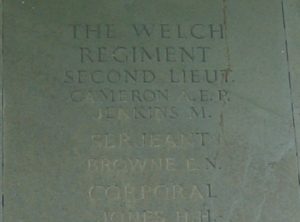
David John Price, Sapper, 4032873, Royal Engineers. David was born at Penderyn in 1917, the son of Gwilym Rees Price and Cecilia Price (nee James). He enlisted into the Royal Engineers and was posted to North Africa with the 9th Field Squadron, Royal Engineers. David was killed in Egypt on 20 July 1942. The 25-year-old is buried in Tel El Kebir War Memorial Cemetery, Egypt. His brother, Richard Rees Price, was captured by the Japanese at Singapore in February 1942, but survived the war.